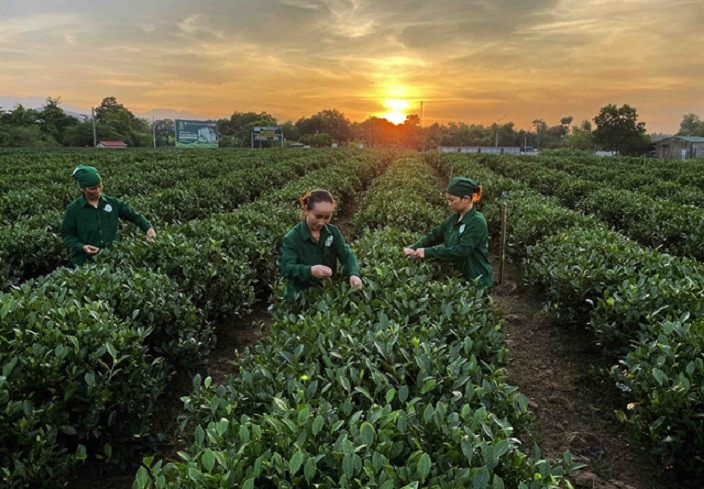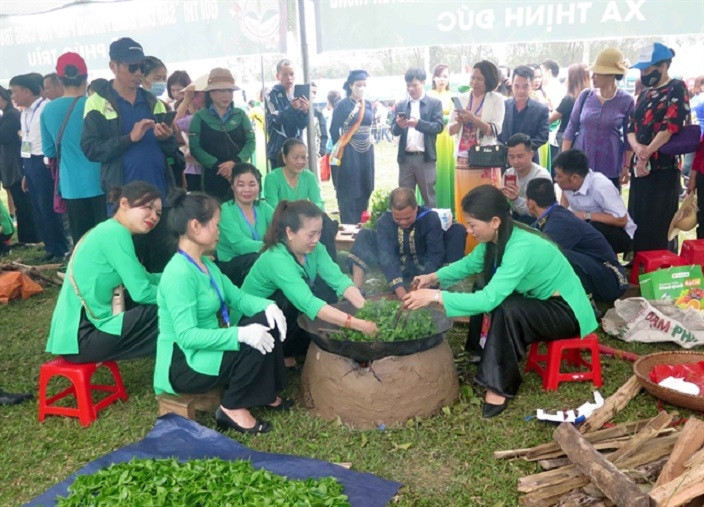
The province is home to more than 1,000 cultural and historical relics, and many national intangible heritages and archaeological sites.
It is known as an attractive destination for tourism, with renowned landscapes and the largest tea cultivation area in Việt Nam.
"Thái Nguyên is a semi-mountainous land, with favourable natural conditions creating an ecological region very suitable for the growth and development of tea plants," said Nguyễn Thanh Bình, vice chairman of the provincial People's Committee.
"With an area of 22,300ha for growing tea, Thái Nguyên is one of the leading provinces in the country in terms of cultivated area for tea trees. Tea has been closely associated with the local land and people for a long time. Tân Cương Commune tea is the best, and honoured as the 'Number One Tea' of Việt Nam. The tea tree, which was once grown as a 'tool' to help farmers eradicate hunger and reduce poverty, now helps to enrich and create community tourism."
It has been more than 100 years since the first small-leaf tea trees were brought to and planted in Tân Cương, about 10km southwest of Thás Nguyên City centre. A few trees from 1921 have now grown into vast tea fields.
"Tân Cương tea is praised for its unique flavour, with a gentle scent of green rice, astringent-sweet taste, and complete lack of bitterness," said Đào Thanh Hảo, director of Hảo Đạt Tea Cooperative.
"The brew is not green like tea from other regions but an attractive honey-like yellow. The eye-catching colours and unique flavours are rare to find anywhere else."
The local soil is said to contain trace elements in appropriate proportions that are endemic to the tea trees. The water source taken from natural water from Núi Cốc Lake enhances the delicious and rich taste of the tea. Meanwhile, the microclimate east of the Tam Đảo mountain range, at around 1,000m high, is ideal for growing the crop.
Thái Nguyên tea is now exported to many countries and territories around the world, such as Russia, America, Japan, Europe, and the Middle East.
The local authority issued a resolution approving a project to preserve and develop the Tân Cương specialty tea region for 2021-25. It requires 100 per cent of tea products to be produced by joint enterprises and cooperatives according to safety standards. All must have planting area codes, packaging facility codes, and traceability stamps. As many as 70 tea products will be certified to meet One Commune, One Product standards by 2025.
The province has built a Tea Culture Space under the Thái Nguyên Museum in Tân Cương. There are many documents and artefacts on growing, caring for, and processing tea. Visitors are given information about tea's history, with different demonstrations on how to brew the beverage and drink it correctly.
Next to the Space is Hảo Đạt Tea Cooperative, one of the largest units that grows and produces tea in the area. As one of the places that offer community tourism service, visitors can harvest tea leaves with the staff in the early morning and take part in tea processing activities such as tea hand-rolling, drying and packing.
Tea also plays a key role in Thái Nguyên's cuisine. The fragrance of the tea buds and leaves makes braised fish, grilled pork, fried tofu cakes and boiled eggs much more delicious. Mat-cha ice cream, jelly, and peanut candies are offered as special desserts.
The “Hương Sắc Trà Xuân” Festival is organised every year, to promote and honour tea farming
It is also an opportunity for tea growers, processors, and tea lovers to meet and exchange experiences in making delicious tea. This is also an opportunity for Tân Cương tea to be promoted to a larger community.
At the festival, many exciting activities are organised, such as contests of quick tea leave picking and processing tea using traditional manual methods, traditional folk games, and sports and music performances.
According to Vice Chairman Bình, Thái Nguyên identified tourism associated with tea culture as one of the key tasks of the province tourism development project for 2021-25
Tourism

The tourism industry here focuses on cultural, spiritual, and historical tourism; ecotourism; community and rural tourism associated with tea culture; meetings industry tourism; and adventure sports.
"Thái Nguyên attracts not only historical and cultural tourists but also those interested in ecotourism and community-based tourism," said Nguyễn Ngọc Tuân, director of Thái Nguyên Culture, Sports and Tourism Department.
"This is a land of green mountains and blue waters with many famous landscapes, while the eastern part of the Tam Đảo mountain range in Thái Nguyên has wild, majestic natural landscapes with many streams, waterfalls, and natural rocky reefs."
He added that Thái Nguyên is home to 51 out of 54 ethnic people groups of Việt Nam.
Núi Cốc Lake is the most renowned tourist destination in the region. The lake, which was created from a dam built in Công River in Đại Từ District, is well-known for its spectacular and legendary beauty. With 89 large and small islands, Núi Cốc Lake is both an irrigation project and a beautiful landscape amid mountains and forests.
People can take a cruise to explore the lake, visiting islands and enjoying dozens of fun activities such as playing at the water park, aqua-sailing or visiting Legend Palace.
The province has established a project to build a tourist resort connected with special national historical relic site ATK Định Hóa. The Safety Zone in Định Hóa Commune (ATK Định Hóa) used to provide shelter to the leadership of the war of resistance against the return of the French.
From 1947-54 at this military headquarters, President Hồ Chí Minh and many comrades made important decisions important for the national destiny. Among them were strategic military campaigns such as the Việt Bắc counteroffensive, Northeast and Northwest campaigns, and the Border campaign.
Twenty relic sites in the safety zone have been recognised as national relics closely associated with the images of President Hồ and other high-ranking party and government leaders such as Khau Tý Hill, Tỉn Keo Hill, and Khuôn Tát Waterfalls.
In addition to historical tourism, the region also offers interesting eco- and community-based tourism. The most notable is the Thái Hải Eco Ethnic Stilt House Village in Thịnh Đức Commune.
It is home to 30 original stilt houses of the Tày ethnic minority people who were relocated from Định Hóa. It is a place where villagers preserve artefacts and the traditional culture and customs of the Tày people, where visitors can immerse themselves in lush green nature, and participate in village life.
The village was the only Southeast Asian representative recognised as the best tourism village in the world in 2022 by the UN World Tourism Organisation.
The Phượng Hoàng Eco-tourism area, which includes Phượng Hoàng Cave and Mỏ Gà Stream, is famed in Thái Nguyên.
Located in Võ Nhai District, it is an ecological space, and unique forest - stream - cave complex. In particular, Mỏ Gà stream offers cool, clear and fresh water all year round, and is a fantastic water cave, highly rated by the Royal British Cave Association.
There is also the Museum of the Cultures of Việt Nam's Ethnic Groups in the city centre, which contains more than 10,000 documents, and artefacts belonging to the cultural heritage of 54 ethnic groups of Việt Nam. In its five showrooms, people can learn about the origins and traditional cultural identities of every ethnic group.
The museum also presents an extensive collection of agricultural, handicraft, and hunting tools. Typical ritual clothes with bright colours and decorative motifs of different ethnic minorities are also exhibited. The unusual costumes of the Tày and Nùng groups are used for worshipping and embroidered with lines and designs that supposedly perceive magical sounds.
"With this year's theme 'From experience to heart,' we hope visitors will feel that Thái Nguyên is a safe and friendly destination offering unique, attractive, and impressive experiences to guests," said Vice Chairman Bình. "Many interesting things await people to explore when they are in our province."
With its amazing tea culture, incredible beauty and huge tourism potential, the province is set to make waves as one of the nation's premier destinations. VNS